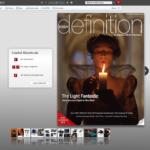
The Story Behind The Launch Of Alexa
Posted on May 13, 2010 by Alex Fice
It was back in 2004 that we first heard about the digital camera journey that Arri were embarking on. They were showing a short film of violinist Nicola Benedetti playing outdoors and indoors in what looked like a period estate house, it had been shot with their experimental digital camera. The people enthusing about Arri’s ‘experiments’ were mainly film guys who weren’t interested in HD cameras derived from ENG roots but wanted their optical viewfinders and film lenses, they wanted the status quo as long as it had Arri on the side of it.
But Arri didn’t at that time have a product until the D20 was quietly introduced a few years later as a rental item. The camera was put to work on mostly TV dramas with the occasional movie until the upgrade of the D21 arrived, consequently nearly at the same time as the camera was available for purchase.
The future for the digital side of Arri seemed set with nomenclature based on ‘D’. Then earlier this year, a few weeks before the IBC Convention in Amsterdam we began hearing rumours of a brand new digital camera system from Arri with three cameras but all with the same sensor.
Although the cameras were launched at IBC, their names A-EV, A-EV Plus and A-OV-Plus are working titles with the official launch at NAB next year. So making up for the D20 having no launch, it looks like we get two this time.
From what Arri learned from the D20/D21 and most importantly their users, they had arrived at some definite goals to achieve with the new cameras. They knew that they had to achieve at least the same picture quality of the D21, a camera that had garnered huge respect from the ASC and BSC in their recent tests. Colourimetry, latitude and pictorially values had to be as good if not better than the D21. No image enhancements to produce crispness that may lead to artifacts or any heavy compression leading to the same results. On-board recording was also seen as a must and something Arri is yet to introduce for the new cameras, but obviously will before NAB next year. (However if you look at how flat the tops of the cameras are you can plainly see where the recorder is destined for).
The cameras had to be smaller, more compact, interestingly more stylish than before, slow motion is mandatory at least up to 60 frames a second. Tapeless is also expected although Sony’s HDCAM SR is still lauded world wide for it’s quality and ease of post workflow. (But of course Arri had always made tapeless cameras – it’s called film!)
People also expect a range of options and accessories and last but absolutely not least, the cameras had to be cost effective.
Two of the camera also had to have electronic viewfinders which was a totally new challenge for Arri. They are LED back lit models with auto calibration so the colour doesn’t drift. You can magnify the image and see around the frame, all in 1280 x720 pixels. The key was to make it short so if you put on a short wide angled lens and Mattebox it wouldn’t effect the viewfinder.
Pixel Counting
As the stills world is realising now, the race for the highest amount of megapixel resolution per product is now being tempered with other ways to gauge image quality. Arri themselves admit that uncompromised 4K resolution will, for some time to come, remain the domain of 35mm film. Arri have learned that the highest resolution doesn’t always equate to the fastest workflow. Post production with some digital cameras has gotten bloated, a recent example if that of District 9, a film that produced 120 TB of data to be turned in to feature length movie.
Arri believe that cinematographers now want increased sensitivity and dynamic range before more pixels.
So their introduction of a 3.5k sensor will then not be a surprise. Milan Krsljanin from Arri GB explains how Arri came to this resolution, “There are two major pipelines these days, High Definition – 1080, 4:2:2, 4:4:4 and 2K. Eighty or ninety percent of features shot on 35mm are completed in 2K. So our emphasis was to make these cameras fit in to HD and 2K workflows and it was working backwards from that goal that we came to our 3.5k figure. So the goals were 800 ASA, 1-60fps on all models, electronic viewfinder on EV and EV Plus, optical on OV with 16:9 sensor and 4:3 sensor for OV. We were aiming to have at least two stops more than the D21 which some people rate at 200 or 250. In addition to that we’ll have Arri-RAW for EV Plus and the OV model and also integrated modules for wireless lens control for the top model.
“The key to the increased performance is what we call ‘Dual Read Out’ – we have on the sensor 32 output channels and we read every pixel twice through a normal gain and through a high gain. Each of these read outs happens in 14 bit depth. We then combine them and get 16 bit pixel depth for every pixel element. So that results in a very quiet image with very low noise. This is a philosophy which is similar to our scanner with its double flashing, however these read outs are happening at the same time.”
Arri promise more ‘magic’ to do with this heavy processing which maybe to do with HDR or High Dynamic Range as its known in stills photography. This is where you combine different exposures in to one, taking the best exposure elements from each to make a extraordinary image. Could this be what Arri have in mind?
“Physically the size of the sensor has to be Super 35mm. If you make it 6K or 4K basically on the same surface you are putting on more pixels, so the pixels are getting smaller and smaller. So you’re probably getting more spatial resolution however each pixel being smaller gets less light so your exposure latitude and your sensitivity go down. Our priority was the optimum sharpness, the maximum sensitivity and the maximum latitude. When we put all these priorities together we came to the conclusion that to achieve all these things the pixel element had to be the size of 8.25 microns which then equates to the 3,456k resolution.”
So how did Arri decide on bringing not one new camera on to the market but three, Milan explained the reasons behind the multiple launch, “The idea was to offer total flexibility in production, very often you may find the OV model accompanied by the A-EV model which could be the B camera. One may have the accessories for wireless control and one for lens control. When you look at them you see a great deal of similarity because the electronics and sensors are the same, the body design and the styling are very similar so every operator can go from one to the other. The OV’s front end is different than the other two that are nearly identical. The EV Plus has extra accessories.
“We see this family as going from mainstream television and documentaries to high end television, commercials to independent movies. With these cameras we believe we will bring a cinematic quality to mainstream television. 20 years ago Arri cameras were used for mainstream television all the time with 16mm. This is the territory we want to re-claim.”
The Cameras
All cameras will use the Alexa III CMOS sensor that is made especially for Arri by a major sensor manufacturer (no names divulged).
The camera design allows certain features to be available on both sides of the camera, another one from the want list from users. The idea was to make the camera easy to use in the middle of the night in gloves at low temperatures. To make the camera dust proof and humidity proof, the entire electronics are hermetically enclosed. The cameras are pumping out some serious heat because of the sensor processing so the back of the camera is basically a huge chimney, radiating the heat away. The fan is very quiet but also very large and is placed at the top, a bottom placed fan will spin air and create a noise. So it sucks the air and doesn’t create that turbulence. Apparently the fan is easy to replace when it starts showing its age. The idea is that one big fan isn’t as noisy as a lot of little fans. The sound performance of the camera is rated at -20dB, as quiet as an Arricam fillm camera.
The first to be available is Alexa at a price of around EURO 50,000. The other cameras will come on stream later in the year but if you wanted to jump the queue there are enticements if you buy a new D21 camera off them.








